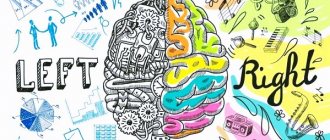Although intellectual ability is one of the most discussed topics in psychology, there is no precise definition of it. And it probably won’t, because the more complex the concept, the more difficult it is to accurately describe it. And each definition will show some facet of the concept. But there are several theories that will help you understand what it is. Some researchers have proposed that intelligence is a general, single ability. Others believe that it involves a range of abilities, skills and talents.
What is intelligence
The concept of intelligence has been a controversial topic throughout the history of psychology. Despite significant interest in this topic, there is still a lot of disagreement. In addition to questions about what intelligence includes and how to define it, there is the question of whether it can be defined at all?
Theories of intelligence provide insight much better than definitions. Important points of intelligence: the ability to learn from personal experience, remember and use knowledge at the right time. Recognize problems and challenges. To use knowledge, a person must be able to identify possible problems that need to be solved. To solve problems. A person should be able to use what he has learned to come up with a profitable solution to a problem he has noticed. All this fits into the concept of intelligence.
Intellectual abilities include:
abilities for logical thinking, reasoning, problem solving, problem solving and planning.
Psychologists often disagree about the definition and causes of intelligence, and intelligence research plays a significant role in many fields. These areas include decisions about how much money to allocate to educational programs, the use of testing to screen job applicants, and the use of testing to identify children who need additional academic help.
On this site you can take small free courses on improving self-esteem, changing your thinking, analytical thinking, creating a business, creativity, public speaking, etc. Which will certainly increase your intellectual abilities.
A Brief History of the Concept of Intelligence
The term intelligence quotient or IQ was first coined in the early 20th century by German psychologist William Stern.
Psychologist Alfred Benet developed the very first intelligence tests to help the French government identify schoolchildren who needed extra academic help. Binet was the first to introduce the concept of mental age, or the range of abilities possessed by children of a certain age.
Since then, intelligence testing has become a widely used tool that has led to the development of many other skills and aptitude tests. However, it remains controversial and controversial over the use of such testing, the cultural biases that may be present, the impact on intelligence, and even the very way in which we define intelligence.
Reflections on thinking
Some psychologists believe that intelligence is a separate ability, others are convinced that it is a combination of different talents, skills and abilities.
However, for the most part, psychologists agree that intelligence is the ability to think logically and rationally, solve problems, understand social norms, traditions and values, analyze situations, learn from experience and overcome life's difficulties.
But they still can't decide whether intelligence can be accurately assessed. To solve this problem, scientists are trying to answer the following questions:
–Is intelligence inherited?
–Do external factors influence intelligence?
–Does intelligence represent a range of skills and abilities or one specific ability?
–Should IQ tests (IQ tests) be considered biased?
–Is it possible to assess intelligence using these tests?
Today there are many theories explaining what intelligence is. Let's list some of them - the most significant.
General intelligence
British psychologist Charles Spearman proposed a two-factor theory of intelligence, according to which two factors can be distinguished in the structure of intelligence: g-factor, that is, general, or general, ability, and s-factor), or specific to specific mental activity. Thus, according to the scientist, there is
a certain general intelligence that determines the mental abilities of a person as a whole, or g-factor; and it can be accurately measured through a special test. Spearman found that people who scored well on one cognitive test also did well on other intelligence tests, and that those who scored poorly on one test did not do well on others. Based on this, the psychologist concluded that intelligence is a general cognitive ability that can be measured and quantified.
Multiple Intelligences
According to psychologist Howard Gardner's theory of multiple intelligences, it is impossible to quantify intelligence. The scientist argued that there are eight different types of intelligence, based on relatively independent abilities and skills, and that some of these abilities can be developed in an individual better than others.
Initially, he identified seven independent types of intelligence:
- spatial (the ability to perceive visual and spatial information),
- verbal (ability to speak),
— logical-mathematical (the ability to logically analyze a problem, recognize relationships between objects and think logically),
- bodily-kinesthetic (the ability to move and exercise physical control over one’s own body),
- musical (the ability to perceive pitch, rhythm and timbre of sound and operate with sound patterns),
- interpersonal (the ability to understand other people and interact with them),
— intrapersonal (the ability to recognize one’s own feelings, emotions and motives).
Subsequently, the scientist included naturalistic intelligence in his model - the ability of a person to live in harmony with nature, explore the environment, and learn from the example of other species.
Primary intellectual abilities
According to psychologist Louis Thurstone, there are seven "primary intellectual abilities" that determine a person's intelligence: verbal comprehension, verbal fluency, numerical, spatial and inductive perception, perceptual speed and associative memory.
Triarchic theory of intelligence
According to psychologist Robert Sternberg's theory of intelligence, there are three different factors of intelligence: analytical or componential (the ability to solve problems), creative or experiential (the ability to cope with new situations using past experiences and existing skills), and practical or contextual (the ability to adapt). to environmental changes).
Birth sequence
Scientists have been trying for decades to understand how birth sequence affects what affects a person's intelligence. But one of the latest studies conducted by the American Psychological Association states that there is no direct relationship between the order of birth of children in a family and their level of intelligence.
Not so long ago, experts believed that it was the first-born children who showed the best results in texts testing intelligence. They explained this by the lack of competition for the attention and care of parents, which allows children to devote more time to receiving and assimilating new information. And children who were born later, according to scientists, experienced a lack of parental care and, as a result, did not show such good results on tests.
As for the latest study specifically, it compared siblings without touching on birth order. And it was possible to establish that there is no significant relationship between birth order and mental characteristics.
Charles Spearman's theory. General intelligence
British psychologist Charles Spearman (1863-1945) described a concept he called general intelligence, or g factor. Using a technique known as factor analysis, Spearman administered a series of intelligence tests and concluded that scores on these tests were remarkably similar. People who performed well on one test tended to do well on others. And those who scored a low number of points in one test, as a rule, received poor grades in the others. He concluded that intelligence is a general cognitive ability that can be measured and expressed numerically.
Intelligence and heredity
Heredity
If you were born to smart parents, does that mean you will be smart too? Some researchers say yes, some deny it. It is true that heredity influences our intelligence quotient (IQ), which measures our cognitive abilities compared to our peers.
But we should not forget about the environment, as well as the role of culture in shaping our intelligence. Are there genes for intelligence? No one knows for sure, and research varies, suggesting 40-80 percent of the genes responsible for intelligence are present.
Genes versus nurture is a controversial area of research, and experiments being conducted today will help us understand not only the functioning of our minds, but also human character, behavior, and even the basis of some mental illnesses.
An important point in this theory is the fact that human intelligence is not dependent on race, and that heredity is not the only factor determining the intellectual potential of an individual.
Craniometry
Scientists in the 19th century believed that measuring a person's skull and facial structure was a good way to measure their intelligence. When this theory first appeared, surgeon Paul Broca suggested an inversely proportional relationship: the smaller the ratio of forearm length to upper arm length, the higher the level of intelligence.
When he failed to prove that whites were the smartest race based on arm length alone, he turned to measuring the skull and facial structures to determine how much brain could fit inside a person's skull. He considered this a more accurate way to determine intelligence.
Craniometry showed that the larger the skull bones, the larger the skull itself and the brain located in it, and, consequently, the higher the intelligence. Craniometry died in the early 20th century because it was constantly criticized for its racial prejudice and lack of factual basis for such claims.
However, scientists interested in this theory helped discover the brain's speech centers and also helped identify the concepts of the intellectual factor we know today as IQ.
Primary mental abilities
In the first half of the 20th century, psychologist L. Thurstone put forward the idea that the basis of human intelligence is seven components. His theory differed from others existing at that time, which argued that human intelligence is based on one factor, not defined which one.
Among the components involved, the psychologist noted the following: associative memory, counting ability, speed of perception, ability to think logically, spatial visualization, verbal understanding and word proficiency.
tabula rasa
Tabula Rasa (Latin for “blank slate”) is the theory that humans are born with “pure minds.” For many centuries this theory has been supported by psychologists and philosophers. She assumes that at the moment of birth a person’s mind is empty and fresh, has enormous potential and awaits filling with life experiences and emotions.
As we have already said, active debate continues today about what is most important for intelligence - education or genetics; should we consider a person exclusively a creation of nature or does the environment play a larger role?
In recent decades, many studies have been conducted in which scientists studied twins separated at birth, because they “contain” the same genetic material, but the environment in which they grow and develop is different. And, according to scientists, a person’s mind, like his other individual traits (for example, gender identity), is a combination of inherited genes, experiences and environmental influences.
Louis L. Thurstone. Primary mental abilities
Psychologist Louis L. Thurstone (1887-1955) proposed a different theory of intelligence. Rather than viewing intelligence as a single, general ability, Thurstone's theory includes seven "primary mental abilities." Among the primary abilities he described are:
- verbal comprehension;
- inductive reasoning;
- fluency;
- perceptual speed;
- associative memory;
- computing ability;
- spatial visualization.
Other definitions of this concept and approaches to understanding it
Let's consider other definitions of this concept.
- The broadest and most basic definition for science was given by Vernon. He defined social intelligence as a person's ability to relate to people in general, the ability to present oneself with ease in society, an understanding of social issues, sensitivity to the stimuli of other group members, an understanding of changeable moods and seeing the hidden sides of personality.
- 17 years after the first mention, psychologist G. Allport defined social intelligence as the ability to make quick judgments about people, predicting their likely reactions. Allport believed that social intelligence smoothes relationships between people.
- J. Guilford defined SQ as the ability to understand and predict people’s behavior under different circumstances, to understand intentions, feelings, and emotional states at the verbal and nonverbal levels.
Russian psychologists also asked this question.
- Thus, Emelyanov understood the term “social intelligence” as a stable, effective response and social experience based on the specifics of thinking. The ability to understand oneself and others, their relationships and the ability to make predictions regarding interpersonal events.
- V.N Kunitsyna defines social intelligence as a multidimensional complex structure - a global ability formed on the basis of complex intellectual, personal, communicative and behavioral characteristics, including the level of energy supply of self-regulation processes; together they determine the forecast of how interpersonal situations, perception of information and behavior, readiness for socialization and decision-making will develop.
- Ushakov defines social intelligence as follows:
- A special ability that is different from the rest.
- Social competence, a set of knowledge, abilities, skills acquired by a person throughout his life.
- Ushakov also emphasizes that SQ determines how successful social interaction will be.
The Problem of Abilities
What are abilities? Abilities are qualities, abilities or skills that distinguish one person from another. They can be mathematical, musical, physical and many others. They are based on innate abilities (memory, thinking, attention). And also the features include giftedness, talent and even genius.
Abilities are the individual psychological characteristics of a person. They, in turn, ensure the successful implementation of certain activities. Since they are purely individual, the speed and result of performing the same type of activity differ among people.
If you look at a group of people, it is impossible to determine their level of development and what abilities they have. But if you take a certain person, study his intellect, find out his abilities and inclinations, and then compare him with another person, then you can understand that these concepts are purely individual and absolutely identical people do not exist.
Howard Gardner. Multiple Intelligences
One of the latest and most interesting theories is the theory of multiple intelligences developed by Howard Gardner. Instead of focusing on analyzing test scores, Gardner stated that the numerical expression of human intelligence is neither complete nor accurate in describing a person's abilities. His theory describes eight different intelligences based on skills and abilities that are valued across cultures:
- visual-spatial intelligence;
- verbal-linguistic intelligence;
- bodily-kinesthetic intelligence
- logical-mathematical intelligence
- interpersonal intelligence;
- intrapersonal intelligence;
- musical intelligence;
- naturalistic intelligence.
Linguistic or verbal-linguistic intelligence
This is the ability to use speech in its various manifestations, orally and in writing. People characterized by this type are excellent speakers. They know how to talk about everything in an interesting way, keeping the audience's attention. It is easy for them to memorize texts and write essays.
Kids with this type of thinking easily learn poems and recite them with pleasure. The alphabet is easy for them. They begin to read and write early and love books. Such children quickly master foreign languages and love word games. They enjoy participating in plays.
Holders of this type of intelligence become writers, politicians, journalists, editors, and translators. The professions of literature teachers, trainers, TV presenters, and lawyers are also suitable for them.
Logical-mathematical intelligence
This is a manifestation of logical and abstract thinking, the ability to compare objects mentally without having them in sight. These are lovers of mathematical precision and calculations, the method of deduction and analysis, and finding cause-and-effect relationships.
Children with the logical-mathematical type quickly learn to classify, understand abstract concepts and draw conclusions and conclusions. They like logic puzzles, puzzles, number games and all kinds of calculations. They love scientific experiments and science-related books.
The choice of a future profession is also usually related to science. Such people become mathematicians, physicists, astronomers, engineers, accountants, and programmers.
In what year did Thorndike coin the term and what is the history of the SQ concept?
The concept of intelligence was introduced by Cicero as the ability to understand. Then his thought was continued by Plato, Aristotle and others. The definition of social intelligence was first introduced by E. Thorndike in 1920, so this concept can be considered relatively young for psychology. It sounds like the ability of people to act wisely in human relationships. But this definition was far from the only one.
In total, the following time periods can be distinguished in history:
| A period of time | Decoding |
| 1920-1924 | The American journal Psychology and Education convened a round table to find out what the concept of “social intelligence” is. |
| 1925-1938 | Conducting psychometric studies of social intelligence. The term has been translated into standard measures of individual differences. |
| From the late 1930s to 1965 | SQ research was stopped and found unpromising. |
| 1965-1969 | SQ is considered in the structure of intelligence. |
Study and measurement methods
The first reliable measurement of the concept of social dimension was proposed by Gilflod. It measures the general level of social intelligence, as well as the extent to which a person can foresee the consequences of his actions, reflect the expression of behavior at the verbal and non-verbal levels, and understand the logic of the development of events in difficult situations. In addition to IQ level, there is also a value called intelligence quotient. This term was introduced by the German scientist Stern. This is the name of a quantitative indicator of the level of intellectual development of an individual. So, oligophrenics have low intelligence, the majority of the world's population has an average level. The average level correlates a person's intelligence level with the average person in one age category.
Special testing helps determine the coefficient. Each test designed to determine IQ contains a set of tasks, the complexity of which gradually increases. Problems may include questions of relative logical, spatial, abstract thinking and so on.
Today there is no single standard for measuring and defining IQ.
Vernon's hierarchical model
A hierarchical model of intelligence that establishes the existence of a number of specific abilities, which, as a rule, are grouped under various factors. Vernon presented three types of factors:
-General factor
-Main group factors. He called these factors v:ed (verbal: educational) and k:m (spatial: mechanical).
-Minor group factors that made reference to factors much more directly related to abilities or skills specific to performance in specific tasks.
Vernon's contributions to psychology were many and varied, and his work in the field of intelligence was very remarkable. He was an advocate of the Hebbian theory of intelligence, which divides human intellectual abilities into two categories.
He called "Intelligence A" the biological substrate of cognition through which we learn and adapt, and "Intelligence B" the environmental influences that correspond to the level of skill demonstrated in behavior.
Vernon included "Intelligence C" as measured by tests of cognitive ability, proficiency, or IQ obtained on a particular test.
Guilford's theory of intellectual structure
This is seen as a continuity between Thurstone's model and Binet's initial approaches. Guilford's intelligence approaches cognitive concepts of intellectual functioning, wanting to know and describe cognitive processes, as well as their functions, that influence the intellectual abilities implied in people's work.
According to this theory, intelligence and mental abilities can be understood as a cube that represents the intersection of three dimensions: operations (mental processes), content (semantic, symbolic, visual and behavioral) and products (types of responses required or form of acceptance). processed information), counting each of them with a large number of divisions.
Although these factors are independent, being interrelated, they can become psychologically dependent.
He also points out that intelligence is “a systematic set of skills (individual differences) or functions that process information differently.”
Intelligence is said to consist of 120 faculties or independent abilities, which Guilford later expanded to 150. Moreover, he does not consider the existence of a "g" factor or general factors.
Intellectualization in psychology
Intellectualization , one of the forms of psychological defense in which a person closes himself off from his sensory sensations and begins to perceive what he feels on an intellectual level. This helps reduce the influence of emotions on behavior and decisions, and act more wisely and correctly.
But any protective mechanisms of the psyche negatively affect how an individual perceives reality and himself . In this case, intellectualization leads to the fact that the individual ceases to realize the importance of his emotional state.
People who actively use such defenses have difficulty expressing emotions , which complicates interaction with others, especially in the case of close social relationships (love, friendship).
It is considered an integral part of the personality of schizoids (both schizoid accentuation and schizoid personality disorder are implied).
Read about the symptoms and treatment of emotional personality disorder here.
Description of Cattell's technique
What is the meaning of the factor that is included in this concept? Cattell understood a factor as a combination of several superficial qualities of an individual, which can be combined under one common denominator. The questionnaire was published by its creator in 1949. Initially it included Form A and Form B, which were later supplemented with the following tests:
- Form C and Form D, introduced in 1956;
- Form E and Form F, released in 1961;
- Fourteen Factor Adolescent Questionnaire;
- Children's Twelve Factor Test;
- a shortened version for adults, designed for 13 factors.
In order to correctly interpret the results obtained, several counting algorithms are used:
- special,
- abbreviated
- simplified.
Fluid Intelligence
Which has a hereditary and biological component, with a physiological origin, capable of acting in any situation, and which reflects the ability we have to adapt to different situations or problems that arise without the need to have previous experience.
It reflects a person's basic abilities in reasoning and higher mental processes. Fluid intelligence can be measured through tests to obtain a person's ability to acquire knowledge.
Crystallized Intelligence
Complete the previous with acquired knowledge that originates in the person's experience and encompasses the cognitive abilities in which previous learning has crystallized. This intelligence is assessed through school tests and knowledge gained through interaction with the sociocultural environment.
It also links, in its neuropsychological aspect, the different relationships between the cerebral hemispheres and types of abilities.
Stages of developing a questionnaire methodology
When compiling the questionnaire at the first stage, Cattell used the works of psychologists Odbert and Allport, who were engaged in finding words in the English language that could be used to describe the distinctive character traits and behavior of an individual. Since there were a lot of such words (4.5 thousand), it is not surprising that Cattell decided to reduce their number to a reasonable value and used factor analysis to solve this problem. He divided the definitions of human character traits and behavior into groups based on their synonymy, and then chose one word that, in his opinion, most fully reflected the essence of a whole group of words.
Using this method, Cattell reduced the number of characteristics to 171 words. Then, with the help of expert psychologists, Cattell was able to cross-correlate their ratings, from which he was able to select thirty-six correlating galaxies of words that were bipolar or antonymous, for example, “happy - sad.”
Subsequently, Cattell conducted several additional studies that found that the number of bipolar couples can be reduced to sixteen factors. The significance of the knowledge gained is very great, since it contributed to the confirmation of the following psychological theories: the theory of self-control and the theory of introversion and extraversion.
Since sixteen factors were identified only using L-data, they were of little use for use in practice. The fact is that it is not possible to measure the personal characteristics of a large number of people using only L-data, because it is not economically feasible to train a significant number of experts to work with subjects.
Based on this, Cattell made a logical conclusion: it was necessary to study Q-data, which led to the emergence of other, more recent, forms of the questionnaire.
Stenberg's triarchic theory
Developed by Stenberg, a psychologist known for his research on intelligence and creativity, among other topics. His theory was one of the first to take a more cognitive approach.
Defines intelligence as “directed mental activity for the purpose of adapting to relevant real-life conditions in one’s life.”
His theory is divided into three parts: componential or analytical intelligence, experiential or creative intelligence, and contextual or practical intelligence.
Subcomponent
He linked the functioning of the mind to a number of components. These components label them as metacomponents, performance or execution components, and knowledge acquisition components. (Sternberg, 1985). And this links this sub-theory to analytical potential, the ability to separate problems and see solutions that are not obvious.
Experimental sub-theory
It refers to performing tasks correctly in relation to previous experience with it, separating the role of experience in automation and novelty. It is associated with creativity and intuition, very useful for solving new problems and generating new ideas.
Contextual or practical sub-theory
It refers to the mental activity that allows us to adapt to our environment. Three processes are given, such as adaptation, conformation or transformation and selection, producing adjustments between them and their environment. The efficiency with which they do this determines their intelligence.
Moreover, he recognizes that a person can achieve the integration of the three intelligences, not just by exhibiting one of them.
Bioecological theory of Cesi
Ceci believes that there are "multiple cognitive potentials", as opposed to a single basic intellectual ability or general intelligence factor. These multiple abilities or areas of intelligence are biologically determined and impose restrictions on mental (mental) processes. Moreover, they are closely related to the problems and opportunities inherent in the individual environment or context. See→
Additional theories that have made important contributions to today's understanding of intelligence
Theory of emotional intelligence
Emotional intelligence is “the ability to manage one’s own and other people’s emotions, to differentiate between different emotions and label them appropriately, and to use emotional information to guide thinking and behavior. Those. People who are good at dealing with their feelings and problems usually have a developed ability to understand others, and from this comes management skills, leadership qualities, etc. In general, this is called emotional intelligence. The theory of emotional intelligence was developed by Peter Salovey and John Mayer.
This type of intelligence is one of the important components of success in society. Even IQ contributes to a person’s success much less.
Emotional intelligence includes:
- empathy
- self-awareness
- self management
- social awareness
- communication skills and relationship management
Read more about emotional intelligence
Fluid and Crystallized Intelligence
Raymond Cattell was the first to propose the idea of a fluid and crystallized intellect.
Fluid intelligence is the ability to solve problems in new situations without referring to previous knowledge, but with the help of logic and abstract thinking. It can be applied to any new problem because no specific prior knowledge is required. As a child gets older, the flexibility of intelligence increases and then begins to decrease (from about age 20).
Crystallized intelligence refers to the use of previously acquired knowledge, such as specific facts learned in school or certain motor skills or muscle memory. As you get older and gain knowledge, it increases.
The difference between the two types of intelligence : If you take a difficult math test, you rely on your crystallized intelligence, it is needed to process numbers and the meaning of questions, but you can use fluid intelligence to work through a new problem and come to the right solution. For example, this translates into creativity and the creation of new ideas. Flexible can become crystallized intelligence.
The new solutions you create by relying on fluid intelligence can become crystallized over time once they are incorporated into long-term memory.
Three types of intelligence
Sternberg develops a theory in which he considers the existence of three types of intelligence that explain information processing internally, externally, and at the level of interaction between them.
In other words, consider the existence of three basic abilities that define intellectual ability. In particular, it establishes the existence of analytical intelligence, practical intelligence and creative intelligence.
Analytical or component intelligence
For Sternberg's triarchic theory of intelligence, analytical intelligence involves the ability to collect, store, modify, and manipulate information. It is closest to the unitary concept of intelligence, referring to the ability to make plans and manage cognitive resources. With analytical intelligence, we can perform mental operations such as identifying, deciding, and generating solutions.
In this intelligence we can find elementary components or processes that allow us to work on cognitive representations of reality, change them and put them through processing that allows us to get an answer.
These components can be divided into meta-components or management processes, which allow decisions to be made and notes on how to think and act, and planning, execution or execution components, which are put into action starting from the meta-components and allow the execution of said set plans. for them and acquisition components that allow you to study and obtain information.
Practical or contextual intelligence
This type of intelligence refers to the ability of people to adapt to the environment in which they live. First, the organism tries to survive from what already exists in the environment, taking advantage of the opportunities offered for adaptation.
However, if this is not possible, the person must establish other mechanisms for adaptation and survival. These other processes represent the choice of the environment and incentives to improve their situation and/or shape the environment in cases where it is impossible to change the environment, in this case making changes to the environment to better adjust their capabilities.
For example, a hungry person may choose an environment and move to a place where there is plenty of food, or take advantage of elements present in the environment that were not previously part of their diet to feed themselves, or may decide to change the environment by cultivating a garden of their own food. It is about using cognitive abilities for an adaptive purpose.
Creative or experiential intelligence
This type of intelligence is considered to be the integration of information received from abroad with our psyche. In other words, it is this kind of skill that allows us to learn from our own experience. It is also associated with creativity and solving problems that have not previously arisen.
In this sense, Sternberg notes that the degree of novelty is important from experience and task. Ideally, the task can be novel to a moderate degree, so that the subject can create and respond to new stimuli while having some kind of tool that allows him to cope.
Another important aspect is automation, the ability to reproduce behavior or knowledge without requiring conscious effort. Repeating tasks on different occasions allows you to master them and reduce the level of their novelty and the need for attention to each basic element that is part of them. The higher the level of automation, the higher the level of resources available to successfully solve other problems.
Basic concept
Intelligence , the quality of the psyche, thanks to which people are able to adapt to new circumstances and extract valuable experience from them, make life decisions using previously acquired abilities and knowledge, successfully study, work in areas closely related to mental work, engage in complex, heterogeneous activities, requiring the ability to think outside the box.
Intelligence is essentially a complex of various skills, such as the ability to work with information coming from outside, find logical chains, use logical thinking efficiently, and so on.
Despite the fact that there are animals with fairly high intellectual abilities (monkeys, especially chimpanzees and orangutans, dogs, crows, cats, dolphins, pigs, elephants), humans are superior to them in many ways.
Intelligent behavior is characteristic of both developed animals and humans, but usually this definition is applied to animals.
Intellectual behavior to the actions of a creature aimed at solving a life problem, up to the invention of new methods and algorithms based on an analysis of the situation.
They are not directly related to the creature's instincts and pre-existing abilities. Some animals, having developed a certain algorithm, retain it throughout their lives and even share their achievements with their offspring.
The higher the intelligence of the animal, the more noticeable the manifestations of intellectual behavior will be.
Zoologists actively study the intellectual skills of animals through observation and experimentation .
One of the most remarkable evidence of their intellectual behavior is the use of tools to solve a problem (which is usually obtaining a delicacy that is not directly accessible): sticks, stones.
For example, in the famous raven experiment, researchers place two tall, narrow vessels. One is half filled with water, the other with sand. Each container contains a treat.
The crow can't reach him. After a while, she begins to throw nearby stones into a vessel with water, the water level rises, and she takes the treat.
Some animal species (such as chimpanzees) have even been observed making tools suitable for their tasks.
The concepts of “intelligence” and “thinking” are closely related. Intelligence is often referred to as the ability to use thinking.
And thinking is a specific cognitive skill, thanks to which a person learns about the world around him and analyzes it.
But intelligence includes not only the ability to use thinking, but also the ability to use cognitive abilities in general , because without memory, attention, and perception it is impossible to imagine.
Test procedure
First of all, the test taker is asked to read the instructions, which describe in detail the procedure for taking the questionnaire. Then the specialists provide the person undergoing the study with a form on which he will mark the correct, from his point of view, answer options. Mandatory conditions for passing the test: calm environment; the subject is isolated from other people; The maximum time allocated for all questions is no more than thirty minutes.
Sample instructions
With the help of the questions that you can see in the test, the distinctive features of your personality and character are determined. Any of the answer options is correct, since there are different views on the same things. You need to answer as accurately and as sincerely as possible. First, you need to provide answers to four proposed questions. Based on this, you will be able to understand whether you need additional help from the study organizers.
Keep in mind that from time to time there are questions in the questionnaire for which there is only 1 correct answer. You need to remember the following 4 rules and strictly use them when taking the test:
- you need to give natural answers, those that came to your mind with lightning speed and not waste time thinking;
- it is advisable to give as few answers as possible with an average value or “I don’t know”;
- You cannot skip questions if none of the suggested answers apply to you. In this case, you need to choose the option that is closest to you. If the questions seem too intrusive and invading your personal space, please note that it is impossible to decipher the results without using a key;
- You are required to be completely honest. When taking the test, do not think about what impression you make or how you think you need to answer the questions in order to show yourself to the experimenter.
Processing the results obtained
A key is used to decipher data that is subsequently used to interpret the personal characteristics of the test taker. If the subject's answer matches the key, he is awarded a certain number of points, which are then summed up. The questionnaire uses several questions scattered in random order throughout the test to assess each factor. The sum of points for such questions ultimately gives the value of the required factor.
The research psychologist then transforms the scores into standard units or walls using special tables. After this, the specialist takes the bipolar scale and distributes the walls along it into all sixteen factors, which together form what Cattell called a personality profile.
Theories of intelligence: summary
Despite these differences, all theories of intelligence have a number of common features. They all try to take into account the biological basis of intelligence, whether it is a basic processing mechanism or a set of multiple intellectual abilities, modules or cognitive potentials.
Sources
- https://psixologiya.org/razdely/teorii/2276-teorii-intellekta.html
- https://gabysheva.ru/samorazvitie/teoriya-razvitiya-intellekta.html
- https://lifemotivation.ru/samorazvitie/teoriya-mnozhestvennyh-intellektov-gardnera
- https://ru.thpanorama.com/articles/curiosidades/las-9-teoras-de-la-inteligencia-ms-conocidas-primarias-y-modernas.html
- https://gabysheva.ru/samorazvitie/kettel-oprosnik.html
- https://knyazhinskaya.ru/chelovek/teorii-intellekta-v-psihologii-2.html
- https://ru.yestherapyhelps.com/the-triarchic-theory-of-intelligence-of-sternberg-12742
- https://miss-runet.ru/samorazvitie/obshchaya-teoriya-intellekta.html
[collapse]
Intelligence tests
IQ tests are typically used to assess cognitive abilities, intelligence quotient, and achievement levels. The most common are standard intelligence tests, such as the SAT (Academic Assessment Test) and the Stanford-Binet Test for Gifted Children. These tests evaluate a person's cognitive skills and compare them with those of the general population.
Such tests have been popular for decades among ordinary people, but despite this, today they are increasingly criticized. Some experts, for example, are convinced that there is a certain bias in these tests along various lines: racial, gender, cultural and socio-economic.
Such IQ tests are based on the no longer current idea that human intelligence is something that is determined at birth and does not undergo major changes throughout life. Therefore, scientists who share the opinion that the “old” tests are biased recommend that everyone who takes them not take their results too seriously.











